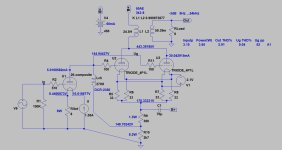Using large (47k or so) grid stoppers is common in guitar amps to fight blocking distortion. For hifi, I would prefer a source or cathode follower direct coupled to the grids. Mosfets are better for the job but I prefer high gm tubes due to the free soft start.
Correctly done it also increases the output power a bit by pushing the output tubes into class A2.
Correctly done it also increases the output power a bit by pushing the output tubes into class A2.
I've been listening to my PSE 4P1L triode amp now for a few weeks. It was by a real stroke of luck that I tried a ECC40 as a driver valve. This rimlock valve was popular in European amps in its day. It's turned out to have a very pleasing tonality indeed. I listen to opera, classical and jazz, and a lot of piano. Acoustic instruments have to be lifelike and piano is critical - it's the decider for valve combinations. With the ECC40 the piano is as good as I have ever had it, and acoustic instruments and voices are very nice too. Part of the good tonality is that my DAC, that feeds the amp directly, uses a PCM56 multi-bit chip and that also has a lovely tone. So here's the schematic, split in two.
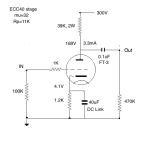
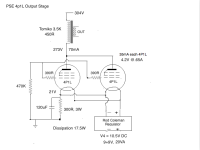


I finally got a round and did something with the small stock of 4P1L that I bought some 13-14 years ago.
A bit of a fridge cleanout regarding the component choices, and also a way of cleaning my brain after spending most of the winter messing with opamp-based crossovers and chip amps (for subwoofer duty only, I'm not completely demented...).
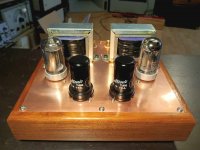
No schematic available yet but it's a very basic design: 12J5 input stages with Hammond 156C chokes as plate loads, cap coupled to the output tubes. Fixed bias, Edcor 5k XSE OPTs.
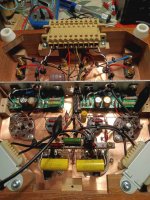
Even with cheap iron it certainly has some interesting qualities. The PSU would benefit from a slight cosmetic touch-up though...:
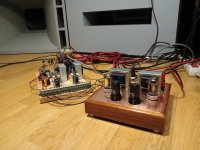
A bit of a fridge cleanout regarding the component choices, and also a way of cleaning my brain after spending most of the winter messing with opamp-based crossovers and chip amps (for subwoofer duty only, I'm not completely demented...).

No schematic available yet but it's a very basic design: 12J5 input stages with Hammond 156C chokes as plate loads, cap coupled to the output tubes. Fixed bias, Edcor 5k XSE OPTs.

Even with cheap iron it certainly has some interesting qualities. The PSU would benefit from a slight cosmetic touch-up though...:

I can see looking back that I was complaining about the bass response with my PSE 4P1L output stage. I'm back using 27 mesh plate into the PSE 4P1Ls and a revised PCM56 DAC to drive it. Good bass now, and the PCM56 has plenty of bass. So looks like a false alarm. I'm very pleased with this setup overall. The output stage of the PCM56 is a pair of AD845 op-amps and I like the sound of those. The DAC drives the 27 > PSE 4P1Ls directly.
Besides my Tomiko 3.5K OPTs I have some larger Ogonowski 5K ones. They presently use CV9s but I'll convert them to PSE 4P1Ls. Doing the work now. They are fine OPTs so I'm expecting good results.
Besides my Tomiko 3.5K OPTs I have some larger Ogonowski 5K ones. They presently use CV9s but I'll convert them to PSE 4P1Ls. Doing the work now. They are fine OPTs so I'm expecting good results.
I did a comparison between 27 mesh plate and 26 in filament bias as drivers for my PSE 4P!L amp in triode. I like both. The 27 is fuller and a more forward sound - quite involving to listen to. The 26 is more subtle, with better piano tone. I could live with either, but I'm going to use the 26 for a while. I listen to a lot of piano and classical/opera as well as jazz. It's nice to have an all-DHT amplifier.
For any potential constructor, I recommend either of these drivers. The 27 is simpler, the 26 in filament bias needs a lot more work, but you do get the satisfaction of a top driver stage which has a lot of fans. The overall gain is enough for my system with 87db speakers and moderate volumes.
For any potential constructor, I recommend either of these drivers. The 27 is simpler, the 26 in filament bias needs a lot more work, but you do get the satisfaction of a top driver stage which has a lot of fans. The overall gain is enough for my system with 87db speakers and moderate volumes.
The ECC40..... More gain than I need in my system. What I liked about it was its tonality on acoustic instruments. I was surprised by how good that was. It was better than the E80CC, and that's a really good sounding tube. My intention was to use it as a DAC output stage, which it does very well. But the 27 and 26 were better.
I've been finding that the 26 in filament bias is quite lean on bass in my system, more so than the 27, so I'm building a 26 stage in cathode bias to compare. I'll report back when it's working.
I've been wondering about using three of 4P1L in parallel instead of two. I probably won't go down that road, though. Using two in parallel requires speakers with a sensitivity of 89db , which I have in my Mission 761s. Sensitivity of 90db, 91db, 92db would be better so I've been looking at my options there.
For those who are using 2x 4P!L in PSE, what sensitivity speakers are you using?
I've been finding that the 26 in filament bias is quite lean on bass in my system, more so than the 27, so I'm building a 26 stage in cathode bias to compare. I'll report back when it's working.
I've been wondering about using three of 4P1L in parallel instead of two. I probably won't go down that road, though. Using two in parallel requires speakers with a sensitivity of 89db , which I have in my Mission 761s. Sensitivity of 90db, 91db, 92db would be better so I've been looking at my options there.
For those who are using 2x 4P!L in PSE, what sensitivity speakers are you using?
- Home
- Amplifiers
- Tubes / Valves
- One more 4P1L SE
